Business and Business Environment: Report on UK Retail Sector
VerifiedAdded on 2020/12/18
|12
|3857
|130
Report
AI Summary
This report provides a comprehensive analysis of the business environment, focusing on different types of organizations, their structures, and functions. Section 1 identifies various organizational types (private, public, and non-profit), detailing their purposes and objectives. It examines the size and scope of organizations (micro, small, medium, and large), highlighting their characteristics and contributions to the UK economy. The report also explores organizational structures (functional, divisional, and matrix), discussing their suitability for different business sizes and operations. Section 2 focuses on the UK retail sector, including a PESTLE analysis to assess the macro-environmental factors impacting the sector and a SWOT and Porter's Five Forces analysis of the UK supermarket industry. The report concludes with a summary of the key findings and insights into the business environment.
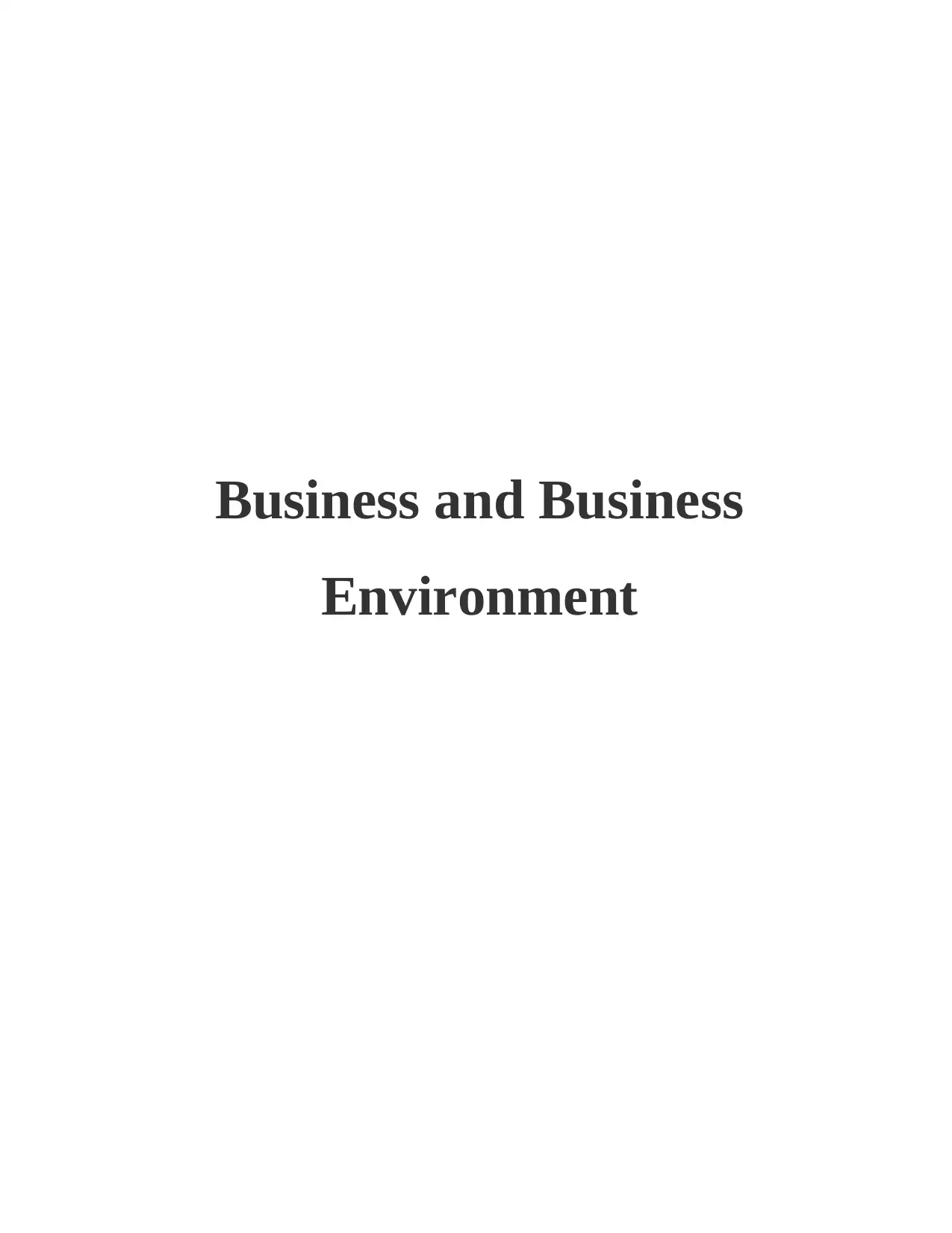
Business and Business
Environment
Environment
Paraphrase This Document
Need a fresh take? Get an instant paraphrase of this document with our AI Paraphraser
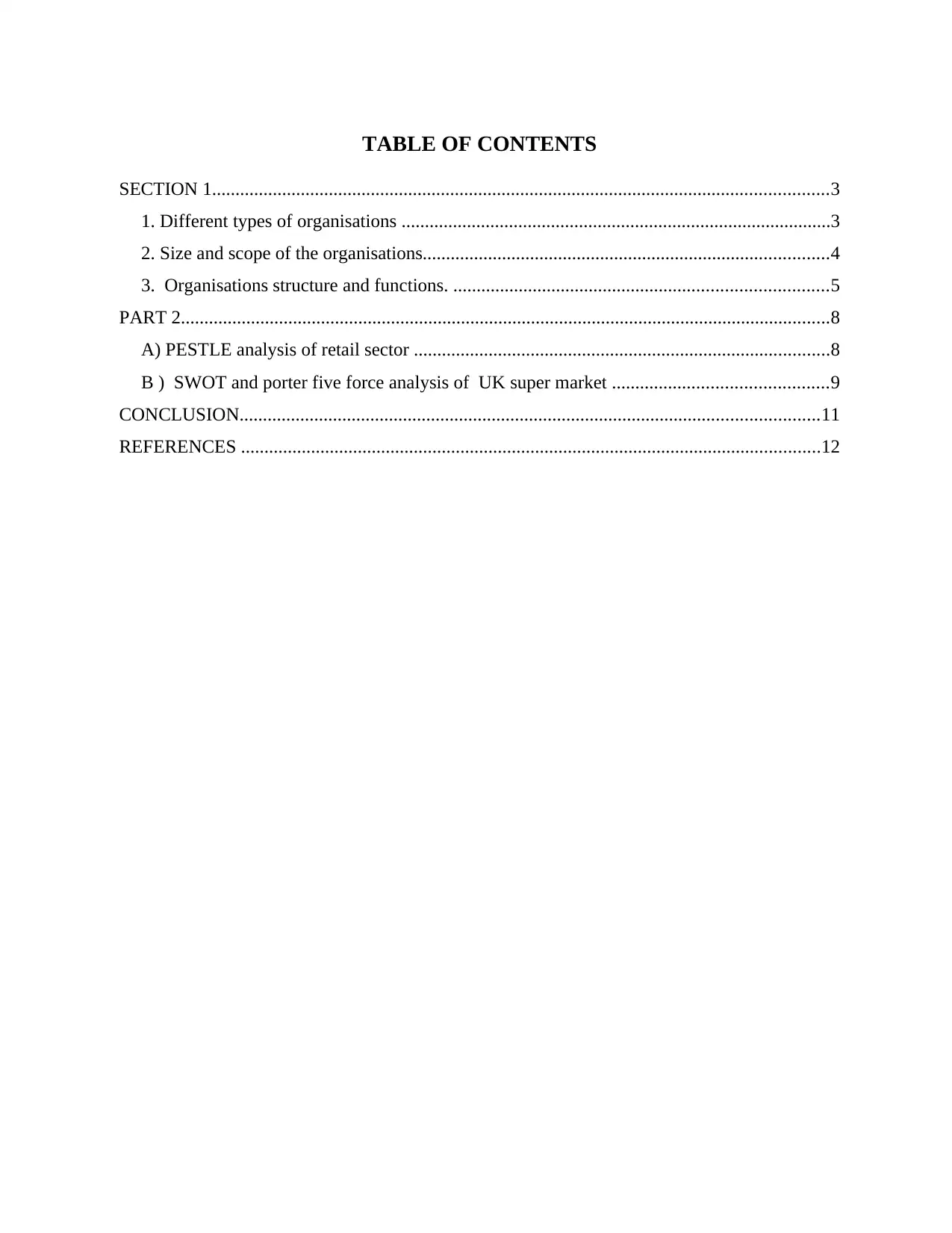
TABLE OF CONTENTS
SECTION 1....................................................................................................................................3
1. Different types of organisations ............................................................................................3
2. Size and scope of the organisations.......................................................................................4
3. Organisations structure and functions. ................................................................................5
PART 2...........................................................................................................................................8
A) PESTLE analysis of retail sector .........................................................................................8
B ) SWOT and porter five force analysis of UK super market ..............................................9
CONCLUSION............................................................................................................................11
REFERENCES ............................................................................................................................12
SECTION 1....................................................................................................................................3
1. Different types of organisations ............................................................................................3
2. Size and scope of the organisations.......................................................................................4
3. Organisations structure and functions. ................................................................................5
PART 2...........................................................................................................................................8
A) PESTLE analysis of retail sector .........................................................................................8
B ) SWOT and porter five force analysis of UK super market ..............................................9
CONCLUSION............................................................................................................................11
REFERENCES ............................................................................................................................12
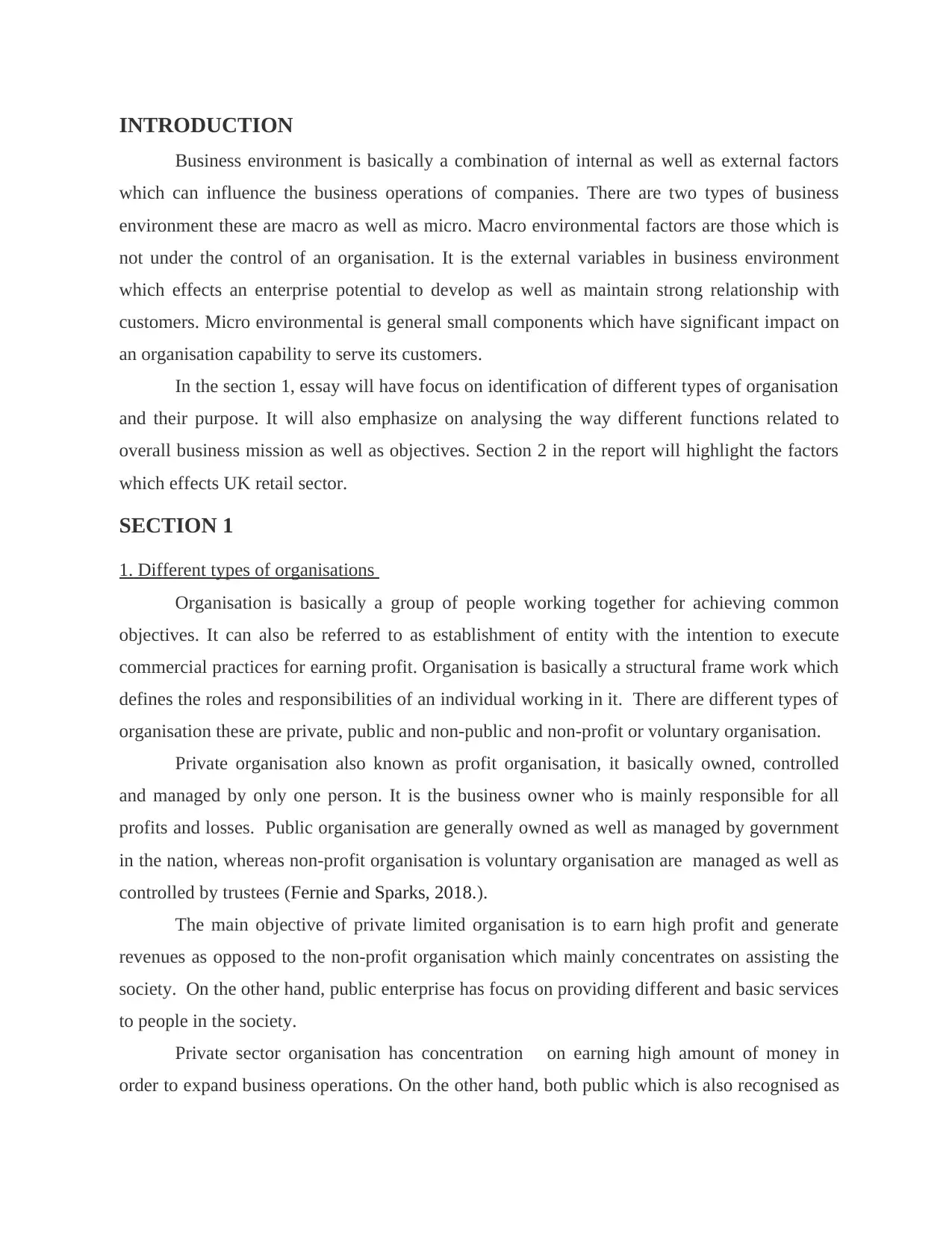
INTRODUCTION
Business environment is basically a combination of internal as well as external factors
which can influence the business operations of companies. There are two types of business
environment these are macro as well as micro. Macro environmental factors are those which is
not under the control of an organisation. It is the external variables in business environment
which effects an enterprise potential to develop as well as maintain strong relationship with
customers. Micro environmental is general small components which have significant impact on
an organisation capability to serve its customers.
In the section 1, essay will have focus on identification of different types of organisation
and their purpose. It will also emphasize on analysing the way different functions related to
overall business mission as well as objectives. Section 2 in the report will highlight the factors
which effects UK retail sector.
SECTION 1
1. Different types of organisations
Organisation is basically a group of people working together for achieving common
objectives. It can also be referred to as establishment of entity with the intention to execute
commercial practices for earning profit. Organisation is basically a structural frame work which
defines the roles and responsibilities of an individual working in it. There are different types of
organisation these are private, public and non-public and non-profit or voluntary organisation.
Private organisation also known as profit organisation, it basically owned, controlled
and managed by only one person. It is the business owner who is mainly responsible for all
profits and losses. Public organisation are generally owned as well as managed by government
in the nation, whereas non-profit organisation is voluntary organisation are managed as well as
controlled by trustees (Fernie and Sparks, 2018.).
The main objective of private limited organisation is to earn high profit and generate
revenues as opposed to the non-profit organisation which mainly concentrates on assisting the
society. On the other hand, public enterprise has focus on providing different and basic services
to people in the society.
Private sector organisation has concentration on earning high amount of money in
order to expand business operations. On the other hand, both public which is also recognised as
Business environment is basically a combination of internal as well as external factors
which can influence the business operations of companies. There are two types of business
environment these are macro as well as micro. Macro environmental factors are those which is
not under the control of an organisation. It is the external variables in business environment
which effects an enterprise potential to develop as well as maintain strong relationship with
customers. Micro environmental is general small components which have significant impact on
an organisation capability to serve its customers.
In the section 1, essay will have focus on identification of different types of organisation
and their purpose. It will also emphasize on analysing the way different functions related to
overall business mission as well as objectives. Section 2 in the report will highlight the factors
which effects UK retail sector.
SECTION 1
1. Different types of organisations
Organisation is basically a group of people working together for achieving common
objectives. It can also be referred to as establishment of entity with the intention to execute
commercial practices for earning profit. Organisation is basically a structural frame work which
defines the roles and responsibilities of an individual working in it. There are different types of
organisation these are private, public and non-public and non-profit or voluntary organisation.
Private organisation also known as profit organisation, it basically owned, controlled
and managed by only one person. It is the business owner who is mainly responsible for all
profits and losses. Public organisation are generally owned as well as managed by government
in the nation, whereas non-profit organisation is voluntary organisation are managed as well as
controlled by trustees (Fernie and Sparks, 2018.).
The main objective of private limited organisation is to earn high profit and generate
revenues as opposed to the non-profit organisation which mainly concentrates on assisting the
society. On the other hand, public enterprise has focus on providing different and basic services
to people in the society.
Private sector organisation has concentration on earning high amount of money in
order to expand business operations. On the other hand, both public which is also recognised as
⊘ This is a preview!⊘
Do you want full access?
Subscribe today to unlock all pages.

Trusted by 1+ million students worldwide
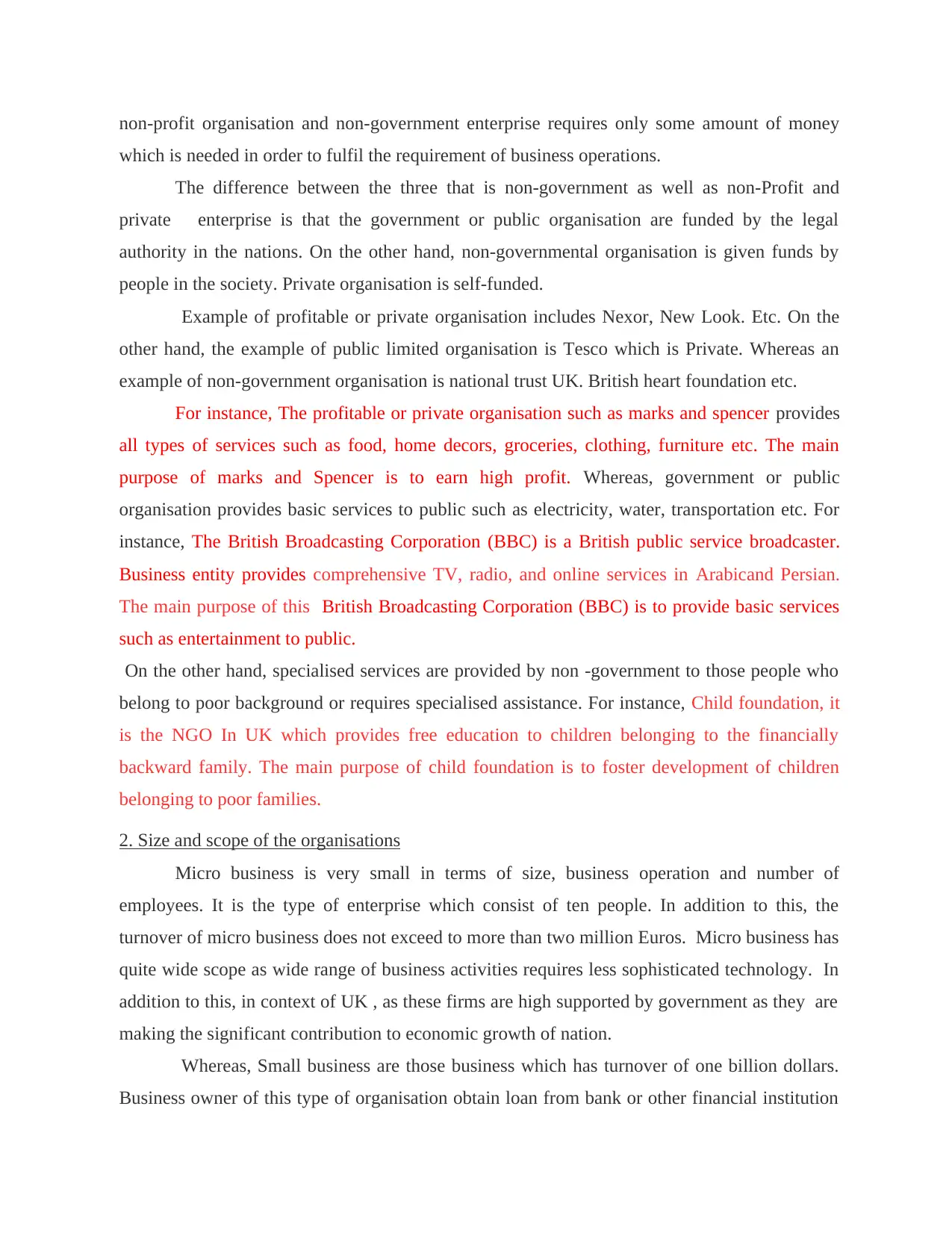
non-profit organisation and non-government enterprise requires only some amount of money
which is needed in order to fulfil the requirement of business operations.
The difference between the three that is non-government as well as non-Profit and
private enterprise is that the government or public organisation are funded by the legal
authority in the nations. On the other hand, non-governmental organisation is given funds by
people in the society. Private organisation is self-funded.
Example of profitable or private organisation includes Nexor, New Look. Etc. On the
other hand, the example of public limited organisation is Tesco which is Private. Whereas an
example of non-government organisation is national trust UK. British heart foundation etc.
For instance, The profitable or private organisation such as marks and spencer provides
all types of services such as food, home decors, groceries, clothing, furniture etc. The main
purpose of marks and Spencer is to earn high profit. Whereas, government or public
organisation provides basic services to public such as electricity, water, transportation etc. For
instance, The British Broadcasting Corporation (BBC) is a British public service broadcaster.
Business entity provides comprehensive TV, radio, and online services in Arabicand Persian.
The main purpose of this British Broadcasting Corporation (BBC) is to provide basic services
such as entertainment to public.
On the other hand, specialised services are provided by non -government to those people who
belong to poor background or requires specialised assistance. For instance, Child foundation, it
is the NGO In UK which provides free education to children belonging to the financially
backward family. The main purpose of child foundation is to foster development of children
belonging to poor families.
2. Size and scope of the organisations
Micro business is very small in terms of size, business operation and number of
employees. It is the type of enterprise which consist of ten people. In addition to this, the
turnover of micro business does not exceed to more than two million Euros. Micro business has
quite wide scope as wide range of business activities requires less sophisticated technology. In
addition to this, in context of UK , as these firms are high supported by government as they are
making the significant contribution to economic growth of nation.
Whereas, Small business are those business which has turnover of one billion dollars.
Business owner of this type of organisation obtain loan from bank or other financial institution
which is needed in order to fulfil the requirement of business operations.
The difference between the three that is non-government as well as non-Profit and
private enterprise is that the government or public organisation are funded by the legal
authority in the nations. On the other hand, non-governmental organisation is given funds by
people in the society. Private organisation is self-funded.
Example of profitable or private organisation includes Nexor, New Look. Etc. On the
other hand, the example of public limited organisation is Tesco which is Private. Whereas an
example of non-government organisation is national trust UK. British heart foundation etc.
For instance, The profitable or private organisation such as marks and spencer provides
all types of services such as food, home decors, groceries, clothing, furniture etc. The main
purpose of marks and Spencer is to earn high profit. Whereas, government or public
organisation provides basic services to public such as electricity, water, transportation etc. For
instance, The British Broadcasting Corporation (BBC) is a British public service broadcaster.
Business entity provides comprehensive TV, radio, and online services in Arabicand Persian.
The main purpose of this British Broadcasting Corporation (BBC) is to provide basic services
such as entertainment to public.
On the other hand, specialised services are provided by non -government to those people who
belong to poor background or requires specialised assistance. For instance, Child foundation, it
is the NGO In UK which provides free education to children belonging to the financially
backward family. The main purpose of child foundation is to foster development of children
belonging to poor families.
2. Size and scope of the organisations
Micro business is very small in terms of size, business operation and number of
employees. It is the type of enterprise which consist of ten people. In addition to this, the
turnover of micro business does not exceed to more than two million Euros. Micro business has
quite wide scope as wide range of business activities requires less sophisticated technology. In
addition to this, in context of UK , as these firms are high supported by government as they are
making the significant contribution to economic growth of nation.
Whereas, Small business are those business which has turnover of one billion dollars.
Business owner of this type of organisation obtain loan from bank or other financial institution
Paraphrase This Document
Need a fresh take? Get an instant paraphrase of this document with our AI Paraphraser
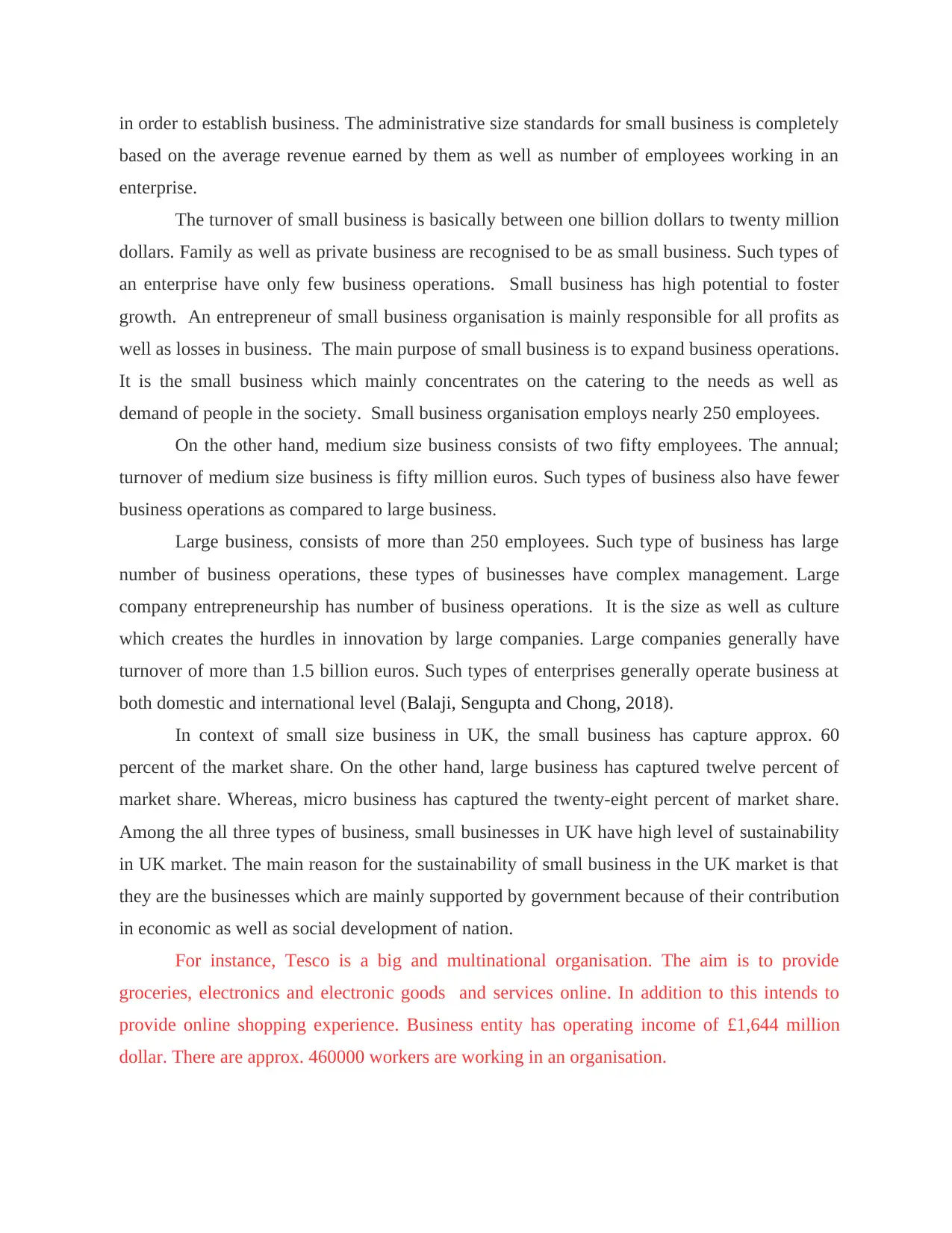
in order to establish business. The administrative size standards for small business is completely
based on the average revenue earned by them as well as number of employees working in an
enterprise.
The turnover of small business is basically between one billion dollars to twenty million
dollars. Family as well as private business are recognised to be as small business. Such types of
an enterprise have only few business operations. Small business has high potential to foster
growth. An entrepreneur of small business organisation is mainly responsible for all profits as
well as losses in business. The main purpose of small business is to expand business operations.
It is the small business which mainly concentrates on the catering to the needs as well as
demand of people in the society. Small business organisation employs nearly 250 employees.
On the other hand, medium size business consists of two fifty employees. The annual;
turnover of medium size business is fifty million euros. Such types of business also have fewer
business operations as compared to large business.
Large business, consists of more than 250 employees. Such type of business has large
number of business operations, these types of businesses have complex management. Large
company entrepreneurship has number of business operations. It is the size as well as culture
which creates the hurdles in innovation by large companies. Large companies generally have
turnover of more than 1.5 billion euros. Such types of enterprises generally operate business at
both domestic and international level (Balaji, Sengupta and Chong, 2018).
In context of small size business in UK, the small business has capture approx. 60
percent of the market share. On the other hand, large business has captured twelve percent of
market share. Whereas, micro business has captured the twenty-eight percent of market share.
Among the all three types of business, small businesses in UK have high level of sustainability
in UK market. The main reason for the sustainability of small business in the UK market is that
they are the businesses which are mainly supported by government because of their contribution
in economic as well as social development of nation.
For instance, Tesco is a big and multinational organisation. The aim is to provide
groceries, electronics and electronic goods and services online. In addition to this intends to
provide online shopping experience. Business entity has operating income of £1,644 million
dollar. There are approx. 460000 workers are working in an organisation.
based on the average revenue earned by them as well as number of employees working in an
enterprise.
The turnover of small business is basically between one billion dollars to twenty million
dollars. Family as well as private business are recognised to be as small business. Such types of
an enterprise have only few business operations. Small business has high potential to foster
growth. An entrepreneur of small business organisation is mainly responsible for all profits as
well as losses in business. The main purpose of small business is to expand business operations.
It is the small business which mainly concentrates on the catering to the needs as well as
demand of people in the society. Small business organisation employs nearly 250 employees.
On the other hand, medium size business consists of two fifty employees. The annual;
turnover of medium size business is fifty million euros. Such types of business also have fewer
business operations as compared to large business.
Large business, consists of more than 250 employees. Such type of business has large
number of business operations, these types of businesses have complex management. Large
company entrepreneurship has number of business operations. It is the size as well as culture
which creates the hurdles in innovation by large companies. Large companies generally have
turnover of more than 1.5 billion euros. Such types of enterprises generally operate business at
both domestic and international level (Balaji, Sengupta and Chong, 2018).
In context of small size business in UK, the small business has capture approx. 60
percent of the market share. On the other hand, large business has captured twelve percent of
market share. Whereas, micro business has captured the twenty-eight percent of market share.
Among the all three types of business, small businesses in UK have high level of sustainability
in UK market. The main reason for the sustainability of small business in the UK market is that
they are the businesses which are mainly supported by government because of their contribution
in economic as well as social development of nation.
For instance, Tesco is a big and multinational organisation. The aim is to provide
groceries, electronics and electronic goods and services online. In addition to this intends to
provide online shopping experience. Business entity has operating income of £1,644 million
dollar. There are approx. 460000 workers are working in an organisation.
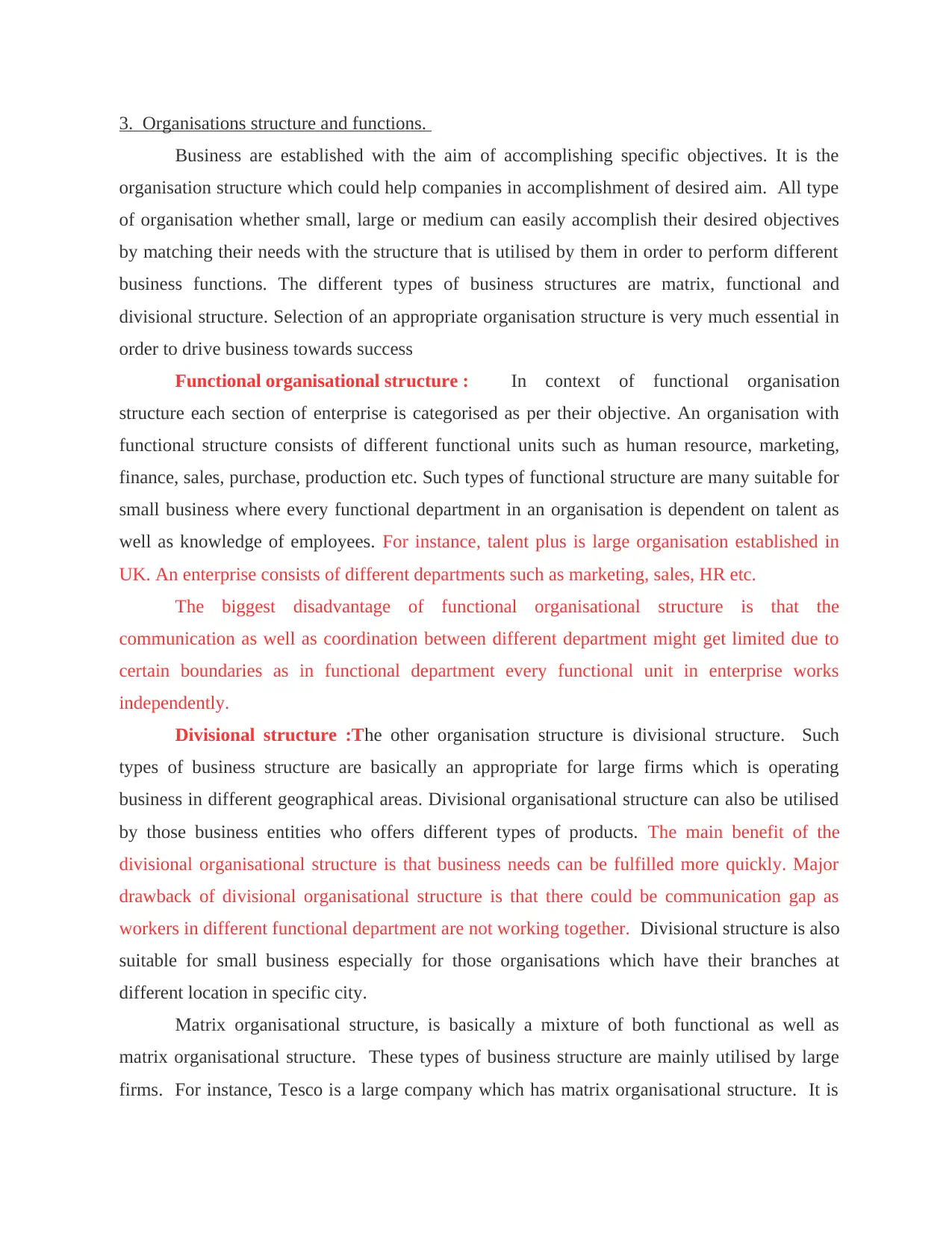
3. Organisations structure and functions.
Business are established with the aim of accomplishing specific objectives. It is the
organisation structure which could help companies in accomplishment of desired aim. All type
of organisation whether small, large or medium can easily accomplish their desired objectives
by matching their needs with the structure that is utilised by them in order to perform different
business functions. The different types of business structures are matrix, functional and
divisional structure. Selection of an appropriate organisation structure is very much essential in
order to drive business towards success
Functional organisational structure : In context of functional organisation
structure each section of enterprise is categorised as per their objective. An organisation with
functional structure consists of different functional units such as human resource, marketing,
finance, sales, purchase, production etc. Such types of functional structure are many suitable for
small business where every functional department in an organisation is dependent on talent as
well as knowledge of employees. For instance, talent plus is large organisation established in
UK. An enterprise consists of different departments such as marketing, sales, HR etc.
The biggest disadvantage of functional organisational structure is that the
communication as well as coordination between different department might get limited due to
certain boundaries as in functional department every functional unit in enterprise works
independently.
Divisional structure :The other organisation structure is divisional structure. Such
types of business structure are basically an appropriate for large firms which is operating
business in different geographical areas. Divisional organisational structure can also be utilised
by those business entities who offers different types of products. The main benefit of the
divisional organisational structure is that business needs can be fulfilled more quickly. Major
drawback of divisional organisational structure is that there could be communication gap as
workers in different functional department are not working together. Divisional structure is also
suitable for small business especially for those organisations which have their branches at
different location in specific city.
Matrix organisational structure, is basically a mixture of both functional as well as
matrix organisational structure. These types of business structure are mainly utilised by large
firms. For instance, Tesco is a large company which has matrix organisational structure. It is
Business are established with the aim of accomplishing specific objectives. It is the
organisation structure which could help companies in accomplishment of desired aim. All type
of organisation whether small, large or medium can easily accomplish their desired objectives
by matching their needs with the structure that is utilised by them in order to perform different
business functions. The different types of business structures are matrix, functional and
divisional structure. Selection of an appropriate organisation structure is very much essential in
order to drive business towards success
Functional organisational structure : In context of functional organisation
structure each section of enterprise is categorised as per their objective. An organisation with
functional structure consists of different functional units such as human resource, marketing,
finance, sales, purchase, production etc. Such types of functional structure are many suitable for
small business where every functional department in an organisation is dependent on talent as
well as knowledge of employees. For instance, talent plus is large organisation established in
UK. An enterprise consists of different departments such as marketing, sales, HR etc.
The biggest disadvantage of functional organisational structure is that the
communication as well as coordination between different department might get limited due to
certain boundaries as in functional department every functional unit in enterprise works
independently.
Divisional structure :The other organisation structure is divisional structure. Such
types of business structure are basically an appropriate for large firms which is operating
business in different geographical areas. Divisional organisational structure can also be utilised
by those business entities who offers different types of products. The main benefit of the
divisional organisational structure is that business needs can be fulfilled more quickly. Major
drawback of divisional organisational structure is that there could be communication gap as
workers in different functional department are not working together. Divisional structure is also
suitable for small business especially for those organisations which have their branches at
different location in specific city.
Matrix organisational structure, is basically a mixture of both functional as well as
matrix organisational structure. These types of business structure are mainly utilised by large
firms. For instance, Tesco is a large company which has matrix organisational structure. It is
⊘ This is a preview!⊘
Do you want full access?
Subscribe today to unlock all pages.

Trusted by 1+ million students worldwide
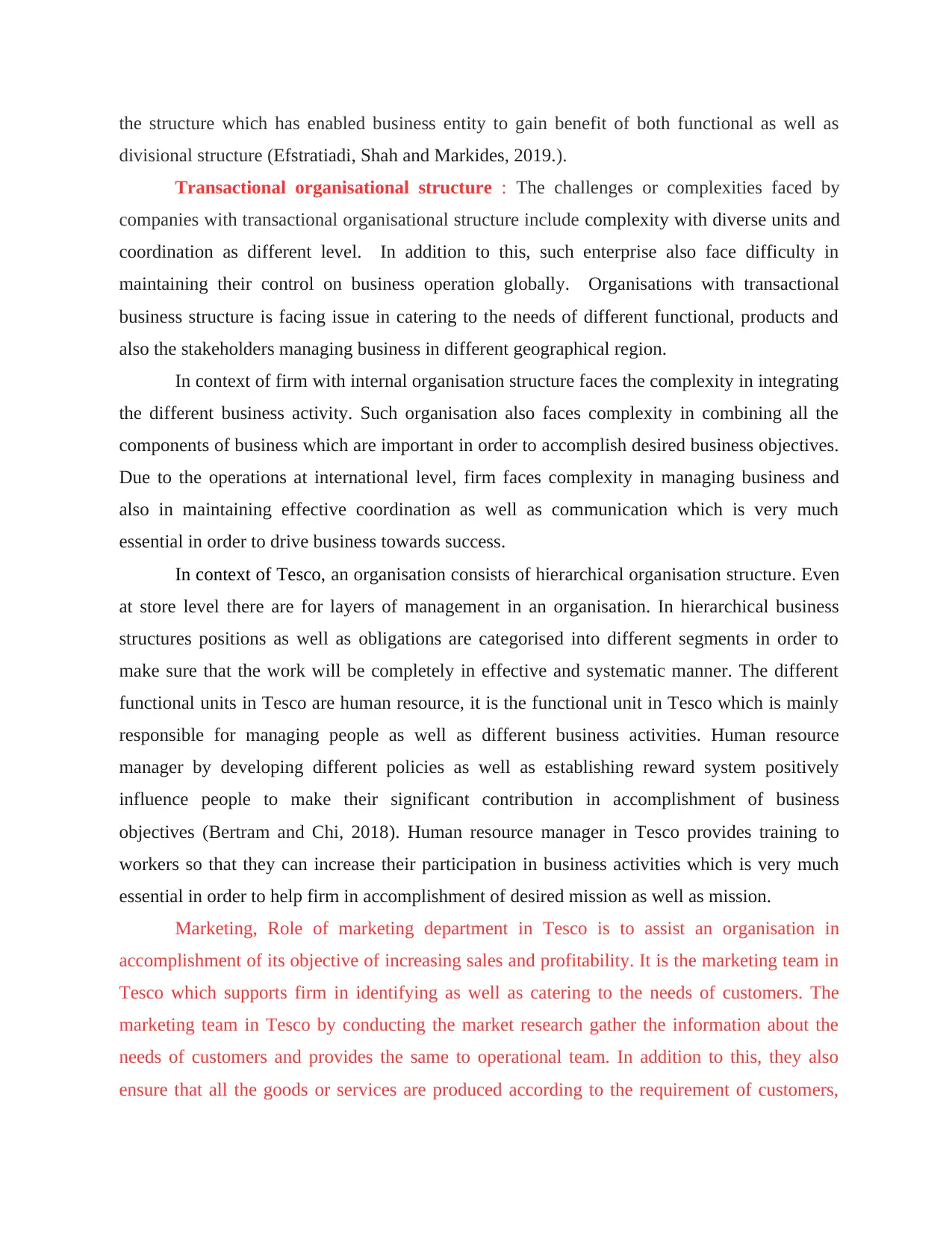
the structure which has enabled business entity to gain benefit of both functional as well as
divisional structure (Efstratiadi, Shah and Markides, 2019.).
Transactional organisational structure : The challenges or complexities faced by
companies with transactional organisational structure include complexity with diverse units and
coordination as different level. In addition to this, such enterprise also face difficulty in
maintaining their control on business operation globally. Organisations with transactional
business structure is facing issue in catering to the needs of different functional, products and
also the stakeholders managing business in different geographical region.
In context of firm with internal organisation structure faces the complexity in integrating
the different business activity. Such organisation also faces complexity in combining all the
components of business which are important in order to accomplish desired business objectives.
Due to the operations at international level, firm faces complexity in managing business and
also in maintaining effective coordination as well as communication which is very much
essential in order to drive business towards success.
In context of Tesco, an organisation consists of hierarchical organisation structure. Even
at store level there are for layers of management in an organisation. In hierarchical business
structures positions as well as obligations are categorised into different segments in order to
make sure that the work will be completely in effective and systematic manner. The different
functional units in Tesco are human resource, it is the functional unit in Tesco which is mainly
responsible for managing people as well as different business activities. Human resource
manager by developing different policies as well as establishing reward system positively
influence people to make their significant contribution in accomplishment of business
objectives (Bertram and Chi, 2018). Human resource manager in Tesco provides training to
workers so that they can increase their participation in business activities which is very much
essential in order to help firm in accomplishment of desired mission as well as mission.
Marketing, Role of marketing department in Tesco is to assist an organisation in
accomplishment of its objective of increasing sales and profitability. It is the marketing team in
Tesco which supports firm in identifying as well as catering to the needs of customers. The
marketing team in Tesco by conducting the market research gather the information about the
needs of customers and provides the same to operational team. In addition to this, they also
ensure that all the goods or services are produced according to the requirement of customers,
divisional structure (Efstratiadi, Shah and Markides, 2019.).
Transactional organisational structure : The challenges or complexities faced by
companies with transactional organisational structure include complexity with diverse units and
coordination as different level. In addition to this, such enterprise also face difficulty in
maintaining their control on business operation globally. Organisations with transactional
business structure is facing issue in catering to the needs of different functional, products and
also the stakeholders managing business in different geographical region.
In context of firm with internal organisation structure faces the complexity in integrating
the different business activity. Such organisation also faces complexity in combining all the
components of business which are important in order to accomplish desired business objectives.
Due to the operations at international level, firm faces complexity in managing business and
also in maintaining effective coordination as well as communication which is very much
essential in order to drive business towards success.
In context of Tesco, an organisation consists of hierarchical organisation structure. Even
at store level there are for layers of management in an organisation. In hierarchical business
structures positions as well as obligations are categorised into different segments in order to
make sure that the work will be completely in effective and systematic manner. The different
functional units in Tesco are human resource, it is the functional unit in Tesco which is mainly
responsible for managing people as well as different business activities. Human resource
manager by developing different policies as well as establishing reward system positively
influence people to make their significant contribution in accomplishment of business
objectives (Bertram and Chi, 2018). Human resource manager in Tesco provides training to
workers so that they can increase their participation in business activities which is very much
essential in order to help firm in accomplishment of desired mission as well as mission.
Marketing, Role of marketing department in Tesco is to assist an organisation in
accomplishment of its objective of increasing sales and profitability. It is the marketing team in
Tesco which supports firm in identifying as well as catering to the needs of customers. The
marketing team in Tesco by conducting the market research gather the information about the
needs of customers and provides the same to operational team. In addition to this, they also
ensure that all the goods or services are produced according to the requirement of customers,
Paraphrase This Document
Need a fresh take? Get an instant paraphrase of this document with our AI Paraphraser
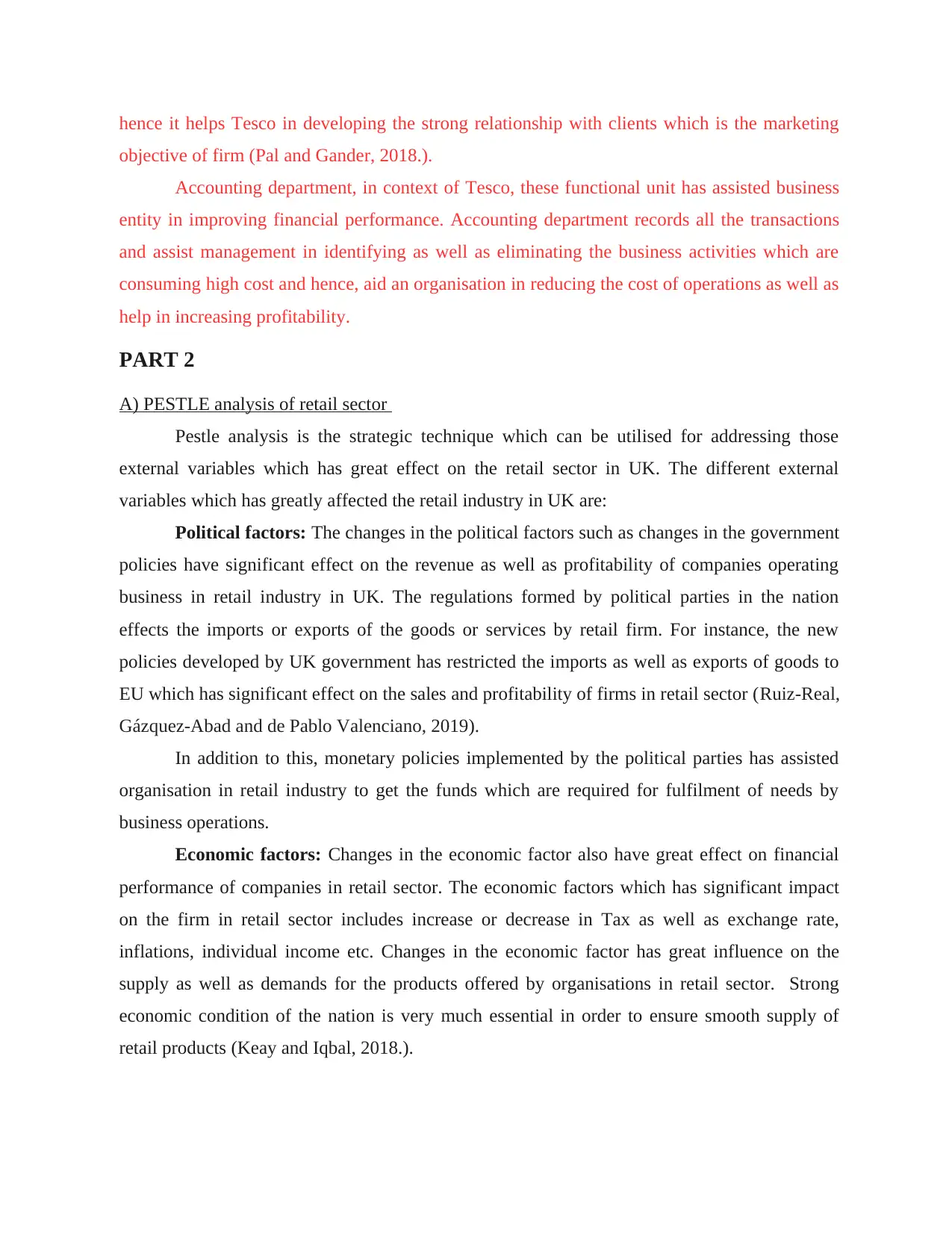
hence it helps Tesco in developing the strong relationship with clients which is the marketing
objective of firm (Pal and Gander, 2018.).
Accounting department, in context of Tesco, these functional unit has assisted business
entity in improving financial performance. Accounting department records all the transactions
and assist management in identifying as well as eliminating the business activities which are
consuming high cost and hence, aid an organisation in reducing the cost of operations as well as
help in increasing profitability.
PART 2
A) PESTLE analysis of retail sector
Pestle analysis is the strategic technique which can be utilised for addressing those
external variables which has great effect on the retail sector in UK. The different external
variables which has greatly affected the retail industry in UK are:
Political factors: The changes in the political factors such as changes in the government
policies have significant effect on the revenue as well as profitability of companies operating
business in retail industry in UK. The regulations formed by political parties in the nation
effects the imports or exports of the goods or services by retail firm. For instance, the new
policies developed by UK government has restricted the imports as well as exports of goods to
EU which has significant effect on the sales and profitability of firms in retail sector (Ruiz-Real,
Gázquez-Abad and de Pablo Valenciano, 2019).
In addition to this, monetary policies implemented by the political parties has assisted
organisation in retail industry to get the funds which are required for fulfilment of needs by
business operations.
Economic factors: Changes in the economic factor also have great effect on financial
performance of companies in retail sector. The economic factors which has significant impact
on the firm in retail sector includes increase or decrease in Tax as well as exchange rate,
inflations, individual income etc. Changes in the economic factor has great influence on the
supply as well as demands for the products offered by organisations in retail sector. Strong
economic condition of the nation is very much essential in order to ensure smooth supply of
retail products (Keay and Iqbal, 2018.).
objective of firm (Pal and Gander, 2018.).
Accounting department, in context of Tesco, these functional unit has assisted business
entity in improving financial performance. Accounting department records all the transactions
and assist management in identifying as well as eliminating the business activities which are
consuming high cost and hence, aid an organisation in reducing the cost of operations as well as
help in increasing profitability.
PART 2
A) PESTLE analysis of retail sector
Pestle analysis is the strategic technique which can be utilised for addressing those
external variables which has great effect on the retail sector in UK. The different external
variables which has greatly affected the retail industry in UK are:
Political factors: The changes in the political factors such as changes in the government
policies have significant effect on the revenue as well as profitability of companies operating
business in retail industry in UK. The regulations formed by political parties in the nation
effects the imports or exports of the goods or services by retail firm. For instance, the new
policies developed by UK government has restricted the imports as well as exports of goods to
EU which has significant effect on the sales and profitability of firms in retail sector (Ruiz-Real,
Gázquez-Abad and de Pablo Valenciano, 2019).
In addition to this, monetary policies implemented by the political parties has assisted
organisation in retail industry to get the funds which are required for fulfilment of needs by
business operations.
Economic factors: Changes in the economic factor also have great effect on financial
performance of companies in retail sector. The economic factors which has significant impact
on the firm in retail sector includes increase or decrease in Tax as well as exchange rate,
inflations, individual income etc. Changes in the economic factor has great influence on the
supply as well as demands for the products offered by organisations in retail sector. Strong
economic condition of the nation is very much essential in order to ensure smooth supply of
retail products (Keay and Iqbal, 2018.).
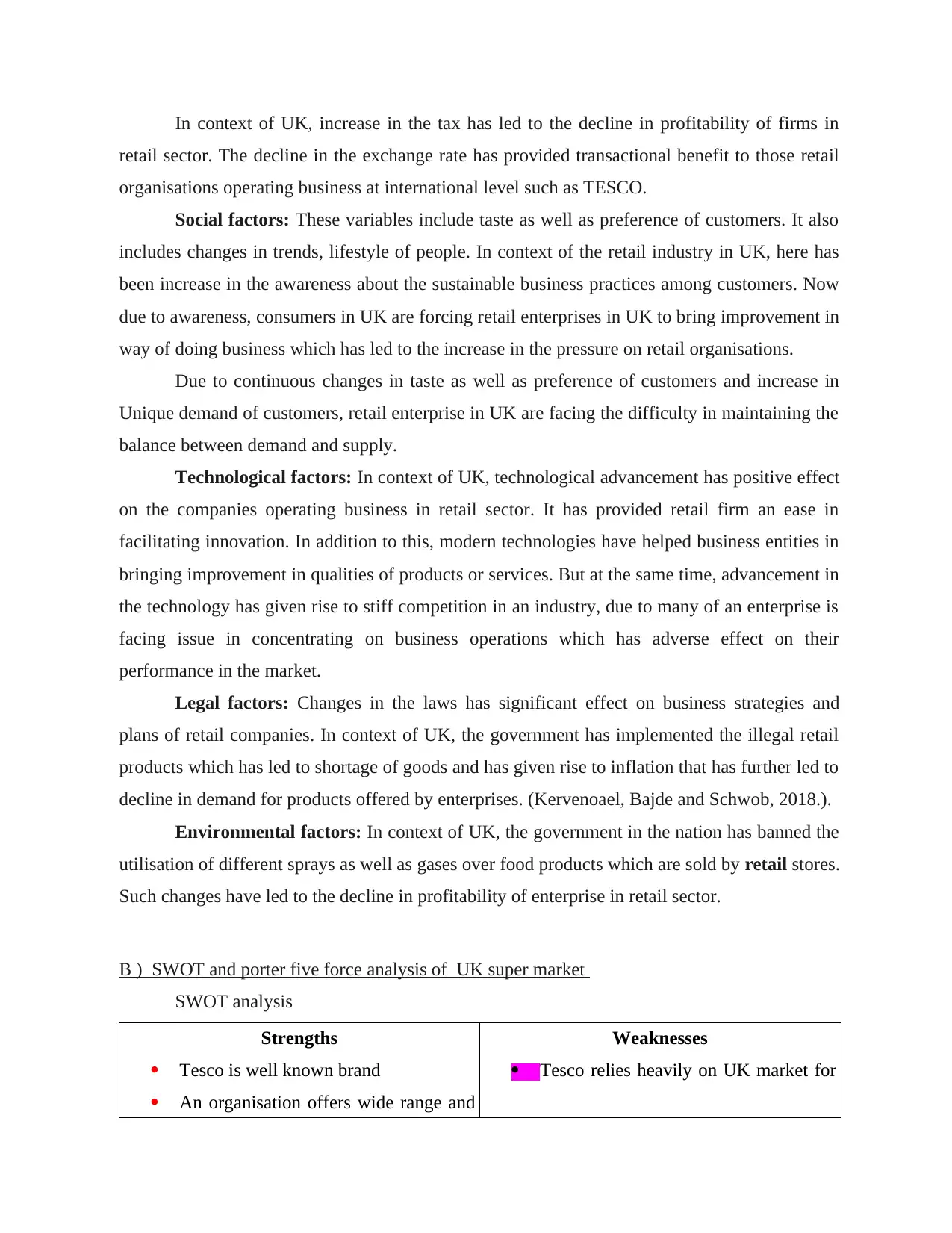
In context of UK, increase in the tax has led to the decline in profitability of firms in
retail sector. The decline in the exchange rate has provided transactional benefit to those retail
organisations operating business at international level such as TESCO.
Social factors: These variables include taste as well as preference of customers. It also
includes changes in trends, lifestyle of people. In context of the retail industry in UK, here has
been increase in the awareness about the sustainable business practices among customers. Now
due to awareness, consumers in UK are forcing retail enterprises in UK to bring improvement in
way of doing business which has led to the increase in the pressure on retail organisations.
Due to continuous changes in taste as well as preference of customers and increase in
Unique demand of customers, retail enterprise in UK are facing the difficulty in maintaining the
balance between demand and supply.
Technological factors: In context of UK, technological advancement has positive effect
on the companies operating business in retail sector. It has provided retail firm an ease in
facilitating innovation. In addition to this, modern technologies have helped business entities in
bringing improvement in qualities of products or services. But at the same time, advancement in
the technology has given rise to stiff competition in an industry, due to many of an enterprise is
facing issue in concentrating on business operations which has adverse effect on their
performance in the market.
Legal factors: Changes in the laws has significant effect on business strategies and
plans of retail companies. In context of UK, the government has implemented the illegal retail
products which has led to shortage of goods and has given rise to inflation that has further led to
decline in demand for products offered by enterprises. (Kervenoael, Bajde and Schwob, 2018.).
Environmental factors: In context of UK, the government in the nation has banned the
utilisation of different sprays as well as gases over food products which are sold by retail stores.
Such changes have led to the decline in profitability of enterprise in retail sector.
B ) SWOT and porter five force analysis of UK super market
SWOT analysis
Strengths
Tesco is well known brand
An organisation offers wide range and
Weaknesses
Tesco relies heavily on UK market for
retail sector. The decline in the exchange rate has provided transactional benefit to those retail
organisations operating business at international level such as TESCO.
Social factors: These variables include taste as well as preference of customers. It also
includes changes in trends, lifestyle of people. In context of the retail industry in UK, here has
been increase in the awareness about the sustainable business practices among customers. Now
due to awareness, consumers in UK are forcing retail enterprises in UK to bring improvement in
way of doing business which has led to the increase in the pressure on retail organisations.
Due to continuous changes in taste as well as preference of customers and increase in
Unique demand of customers, retail enterprise in UK are facing the difficulty in maintaining the
balance between demand and supply.
Technological factors: In context of UK, technological advancement has positive effect
on the companies operating business in retail sector. It has provided retail firm an ease in
facilitating innovation. In addition to this, modern technologies have helped business entities in
bringing improvement in qualities of products or services. But at the same time, advancement in
the technology has given rise to stiff competition in an industry, due to many of an enterprise is
facing issue in concentrating on business operations which has adverse effect on their
performance in the market.
Legal factors: Changes in the laws has significant effect on business strategies and
plans of retail companies. In context of UK, the government has implemented the illegal retail
products which has led to shortage of goods and has given rise to inflation that has further led to
decline in demand for products offered by enterprises. (Kervenoael, Bajde and Schwob, 2018.).
Environmental factors: In context of UK, the government in the nation has banned the
utilisation of different sprays as well as gases over food products which are sold by retail stores.
Such changes have led to the decline in profitability of enterprise in retail sector.
B ) SWOT and porter five force analysis of UK super market
SWOT analysis
Strengths
Tesco is well known brand
An organisation offers wide range and
Weaknesses
Tesco relies heavily on UK market for
⊘ This is a preview!⊘
Do you want full access?
Subscribe today to unlock all pages.

Trusted by 1+ million students worldwide
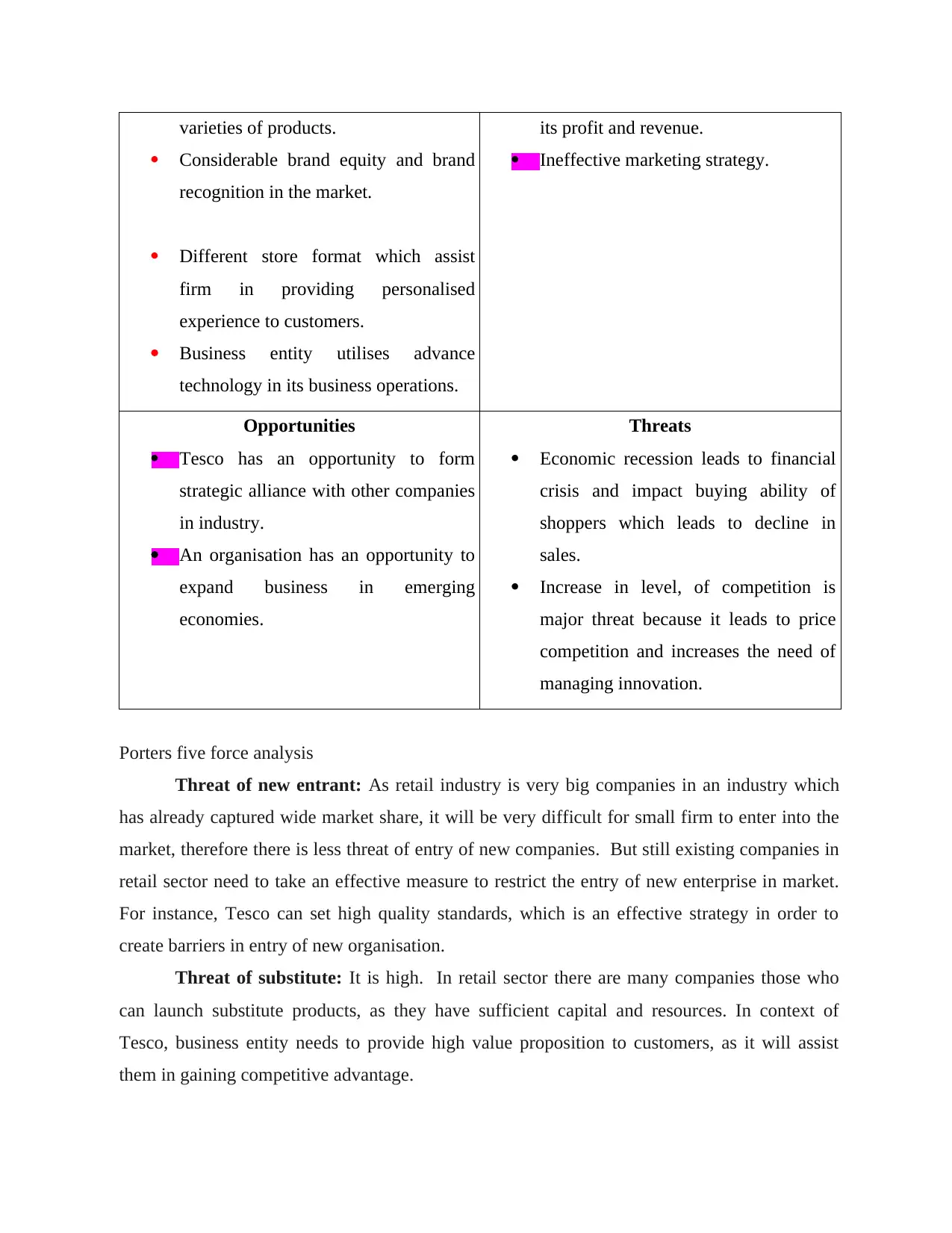
varieties of products.
Considerable brand equity and brand
recognition in the market.
Different store format which assist
firm in providing personalised
experience to customers.
Business entity utilises advance
technology in its business operations.
its profit and revenue.
Ineffective marketing strategy.
Opportunities
Tesco has an opportunity to form
strategic alliance with other companies
in industry.
An organisation has an opportunity to
expand business in emerging
economies.
Threats
Economic recession leads to financial
crisis and impact buying ability of
shoppers which leads to decline in
sales.
Increase in level, of competition is
major threat because it leads to price
competition and increases the need of
managing innovation.
Porters five force analysis
Threat of new entrant: As retail industry is very big companies in an industry which
has already captured wide market share, it will be very difficult for small firm to enter into the
market, therefore there is less threat of entry of new companies. But still existing companies in
retail sector need to take an effective measure to restrict the entry of new enterprise in market.
For instance, Tesco can set high quality standards, which is an effective strategy in order to
create barriers in entry of new organisation.
Threat of substitute: It is high. In retail sector there are many companies those who
can launch substitute products, as they have sufficient capital and resources. In context of
Tesco, business entity needs to provide high value proposition to customers, as it will assist
them in gaining competitive advantage.
Considerable brand equity and brand
recognition in the market.
Different store format which assist
firm in providing personalised
experience to customers.
Business entity utilises advance
technology in its business operations.
its profit and revenue.
Ineffective marketing strategy.
Opportunities
Tesco has an opportunity to form
strategic alliance with other companies
in industry.
An organisation has an opportunity to
expand business in emerging
economies.
Threats
Economic recession leads to financial
crisis and impact buying ability of
shoppers which leads to decline in
sales.
Increase in level, of competition is
major threat because it leads to price
competition and increases the need of
managing innovation.
Porters five force analysis
Threat of new entrant: As retail industry is very big companies in an industry which
has already captured wide market share, it will be very difficult for small firm to enter into the
market, therefore there is less threat of entry of new companies. But still existing companies in
retail sector need to take an effective measure to restrict the entry of new enterprise in market.
For instance, Tesco can set high quality standards, which is an effective strategy in order to
create barriers in entry of new organisation.
Threat of substitute: It is high. In retail sector there are many companies those who
can launch substitute products, as they have sufficient capital and resources. In context of
Tesco, business entity needs to provide high value proposition to customers, as it will assist
them in gaining competitive advantage.
Paraphrase This Document
Need a fresh take? Get an instant paraphrase of this document with our AI Paraphraser
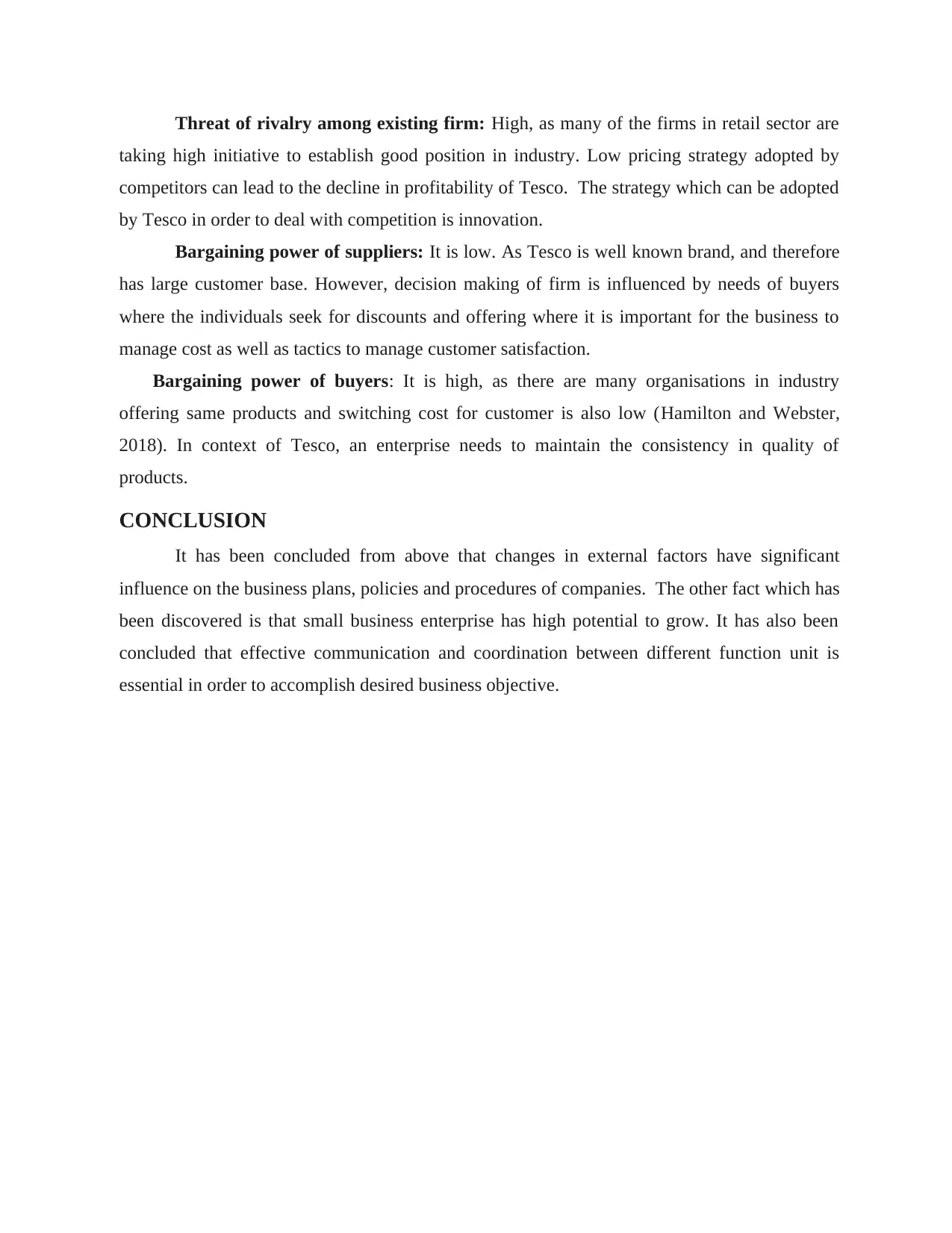
Threat of rivalry among existing firm: High, as many of the firms in retail sector are
taking high initiative to establish good position in industry. Low pricing strategy adopted by
competitors can lead to the decline in profitability of Tesco. The strategy which can be adopted
by Tesco in order to deal with competition is innovation.
Bargaining power of suppliers: It is low. As Tesco is well known brand, and therefore
has large customer base. However, decision making of firm is influenced by needs of buyers
where the individuals seek for discounts and offering where it is important for the business to
manage cost as well as tactics to manage customer satisfaction.
Bargaining power of buyers: It is high, as there are many organisations in industry
offering same products and switching cost for customer is also low (Hamilton and Webster,
2018). In context of Tesco, an enterprise needs to maintain the consistency in quality of
products.
CONCLUSION
It has been concluded from above that changes in external factors have significant
influence on the business plans, policies and procedures of companies. The other fact which has
been discovered is that small business enterprise has high potential to grow. It has also been
concluded that effective communication and coordination between different function unit is
essential in order to accomplish desired business objective.
taking high initiative to establish good position in industry. Low pricing strategy adopted by
competitors can lead to the decline in profitability of Tesco. The strategy which can be adopted
by Tesco in order to deal with competition is innovation.
Bargaining power of suppliers: It is low. As Tesco is well known brand, and therefore
has large customer base. However, decision making of firm is influenced by needs of buyers
where the individuals seek for discounts and offering where it is important for the business to
manage cost as well as tactics to manage customer satisfaction.
Bargaining power of buyers: It is high, as there are many organisations in industry
offering same products and switching cost for customer is also low (Hamilton and Webster,
2018). In context of Tesco, an enterprise needs to maintain the consistency in quality of
products.
CONCLUSION
It has been concluded from above that changes in external factors have significant
influence on the business plans, policies and procedures of companies. The other fact which has
been discovered is that small business enterprise has high potential to grow. It has also been
concluded that effective communication and coordination between different function unit is
essential in order to accomplish desired business objective.
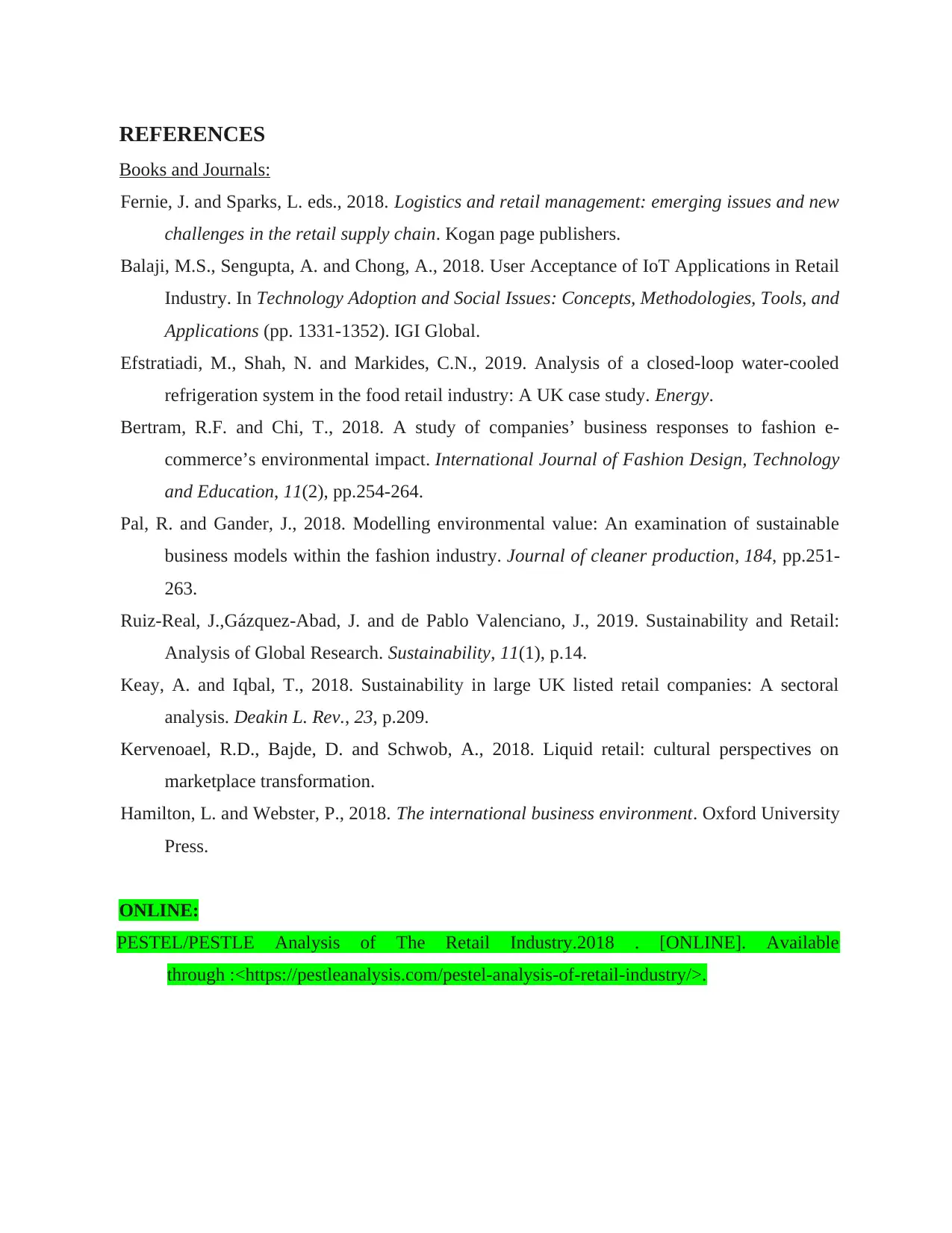
REFERENCES
Books and Journals:
Fernie, J. and Sparks, L. eds., 2018. Logistics and retail management: emerging issues and new
challenges in the retail supply chain. Kogan page publishers.
Balaji, M.S., Sengupta, A. and Chong, A., 2018. User Acceptance of IoT Applications in Retail
Industry. In Technology Adoption and Social Issues: Concepts, Methodologies, Tools, and
Applications (pp. 1331-1352). IGI Global.
Efstratiadi, M., Shah, N. and Markides, C.N., 2019. Analysis of a closed-loop water-cooled
refrigeration system in the food retail industry: A UK case study. Energy.
Bertram, R.F. and Chi, T., 2018. A study of companies’ business responses to fashion e-
commerce’s environmental impact. International Journal of Fashion Design, Technology
and Education, 11(2), pp.254-264.
Pal, R. and Gander, J., 2018. Modelling environmental value: An examination of sustainable
business models within the fashion industry. Journal of cleaner production, 184, pp.251-
263.
Ruiz-Real, J.,Gázquez-Abad, J. and de Pablo Valenciano, J., 2019. Sustainability and Retail:
Analysis of Global Research. Sustainability, 11(1), p.14.
Keay, A. and Iqbal, T., 2018. Sustainability in large UK listed retail companies: A sectoral
analysis. Deakin L. Rev., 23, p.209.
Kervenoael, R.D., Bajde, D. and Schwob, A., 2018. Liquid retail: cultural perspectives on
marketplace transformation.
Hamilton, L. and Webster, P., 2018. The international business environment. Oxford University
Press.
ONLINE:
PESTEL/PESTLE Analysis of The Retail Industry.2018 . [ONLINE]. Available
through :<https://pestleanalysis.com/pestel-analysis-of-retail-industry/>.
Books and Journals:
Fernie, J. and Sparks, L. eds., 2018. Logistics and retail management: emerging issues and new
challenges in the retail supply chain. Kogan page publishers.
Balaji, M.S., Sengupta, A. and Chong, A., 2018. User Acceptance of IoT Applications in Retail
Industry. In Technology Adoption and Social Issues: Concepts, Methodologies, Tools, and
Applications (pp. 1331-1352). IGI Global.
Efstratiadi, M., Shah, N. and Markides, C.N., 2019. Analysis of a closed-loop water-cooled
refrigeration system in the food retail industry: A UK case study. Energy.
Bertram, R.F. and Chi, T., 2018. A study of companies’ business responses to fashion e-
commerce’s environmental impact. International Journal of Fashion Design, Technology
and Education, 11(2), pp.254-264.
Pal, R. and Gander, J., 2018. Modelling environmental value: An examination of sustainable
business models within the fashion industry. Journal of cleaner production, 184, pp.251-
263.
Ruiz-Real, J.,Gázquez-Abad, J. and de Pablo Valenciano, J., 2019. Sustainability and Retail:
Analysis of Global Research. Sustainability, 11(1), p.14.
Keay, A. and Iqbal, T., 2018. Sustainability in large UK listed retail companies: A sectoral
analysis. Deakin L. Rev., 23, p.209.
Kervenoael, R.D., Bajde, D. and Schwob, A., 2018. Liquid retail: cultural perspectives on
marketplace transformation.
Hamilton, L. and Webster, P., 2018. The international business environment. Oxford University
Press.
ONLINE:
PESTEL/PESTLE Analysis of The Retail Industry.2018 . [ONLINE]. Available
through :<https://pestleanalysis.com/pestel-analysis-of-retail-industry/>.
⊘ This is a preview!⊘
Do you want full access?
Subscribe today to unlock all pages.

Trusted by 1+ million students worldwide
1 out of 12
Related Documents
Your All-in-One AI-Powered Toolkit for Academic Success.
+13062052269
info@desklib.com
Available 24*7 on WhatsApp / Email
![[object Object]](/_next/static/media/star-bottom.7253800d.svg)
Unlock your academic potential
Copyright © 2020–2025 A2Z Services. All Rights Reserved. Developed and managed by ZUCOL.




